Machine Learning-Based Prediction of Autism Spectrum Disorder and Discovery of Related Metagenomic Biomarkers with Explainable AI
Abstract
1. Introduction
2. Materials and Methods
2.1. Dataset
2.2. Methods
2.2.1. MicroBiomeGSM
2.2.2. SVM-RCE
2.2.3. RCE-IFE
2.2.4. Feature Selection Methods
2.2.5. Union Method Based on the Features That Are Selected by at Least One of the Best Two Different Feature Selection Algorithms
3. Results
3.1. Model Performance Evaluation
3.1.1. Model Performance Results Based on Taxonomic Grouping (microBiomeGSM)
3.1.2. Comparative Performance Evaluation of SVM-RCE, RCE-IFE, MicroBiomeGSM Models
3.1.3. Comparative Performance Evaluation of Conventional Feature Selection Methods
3.1.4. Performance Evaluation of Selected Union Features
3.2. Potential ASD-Associated Microbial Biomarkers
3.2.1. ASD-Associated Microbial Biomarkers Based on Taxonomic Grouping
3.2.2. ASD-Associated Microbial Biomarkers Obtained from SVM-RCE and RCE-IFE
3.2.3. ASD-Associated Microbial Biomarkers Obtained from Different Feature Selection Methods
3.2.4. ASD-Associated Microbial Biomarkers Obtained Using Union Method
4. Discussion
4.1. Performance Evaluation of Proposed Methods
4.2. Biological Interpretations of the Findings
5. Conclusions
Author Contributions
Funding
Institutional Review Board Statement
Informed Consent Statement
Data Availability Statement
Acknowledgments
Conflicts of Interest
Abbreviations
| ASD | Autism Spectrum Disorder |
| AUC | Area Under the Curve |
| SHAP | SHapley Additive exPlanations |
| XAI | Explainable Artificial Intelligence |
References
- Ganai, U.J.; Ratne, A.; Bhushan, B.; Venkatesh, K.S. Early detection of autism spectrum disorder: Gait deviations and machine learning. Sci. Rep. 2025, 15, 873. [Google Scholar] [CrossRef]
- Lord, C.; Elsabbagh, M.; Baird, G.; Veenstra-Vanderweele, J. Autism spectrum disorder. Lancet 2018, 392, 508–520. [Google Scholar] [CrossRef] [PubMed]
- Hodges, H.; Fealko, C.; Soares, N. Autism spectrum disorder: Definition, epidemiology, causes, and clinical evaluation. Transl. Pediatr. 2020, 9, S55–S65. [Google Scholar] [CrossRef]
- Jabbar, U.; Iqbal, M.W.; Alourani, A.; Shinan, K.; Alanazi, F.; Sarwar, N.; Ashraf, M.U. Machine Learning–Based Approach for Early Screening of Autism Spectrum Disorders. Appl. Comput. Intell. Soft Comput. 2025, 2025, 9975499. [Google Scholar] [CrossRef]
- Rylaarsdam, L.; Guemez-Gamboa, A. Genetic Causes and Modifiers of Autism Spectrum Disorder. Front. Cell. Neurosci. 2019, 13, 385. [Google Scholar] [CrossRef]
- Estes, A.; Swain, D.M.; MacDuffie, K.E. The effects of early autism intervention on parents and family adaptive functioning. Pediatr. Med. 2019, 2, 21. [Google Scholar] [CrossRef]
- Talantseva, O.I.; Romanova, R.S.; Shurdova, E.M.; Dolgorukova, T.A.; Sologub, P.S.; Titova, O.S.; Kleeva, D.F.; Grigorenko, E.L. The global prevalence of autism spectrum disorder: A three-level meta-analysis. Front. Psychiatry 2023, 14, 1071181. [Google Scholar] [CrossRef]
- Gomaa, E.Z. Human gut microbiota/microbiome in health and diseases: A review. Antonie Van Leeuwenhoek 2020, 113, 2019–2040. [Google Scholar] [CrossRef] [PubMed]
- Mejía-Granados, D.M.; Villasana-Salazar, B.; Coan, A.C.; Rizzi, L.; Balthazar, M.L.F.; de Godoi, A.B.; do Canto, A.M.; Rosa, D.C.; Silva, L.S.; Tacla, R.d.R.; et al. Gut microbiome in neuropsychiatric disorders. Arq. Neuropsiquiatr. 2022, 80, 192–207. [Google Scholar] [CrossRef] [PubMed]
- Belkaid, Y.; Hand, T.W. Role of the microbiota in immunity and inflammation. Cell 2014, 157, 121–141. [Google Scholar] [CrossRef]
- Marchesi, J.R.; Adams, D.H.; Fava, F.; Hermes, G.D.A.; Hirschfield, G.M.; Hold, G.; Quraishi, M.N.; Kinross, J.; Smidt, H.; Tuohy, K.M.; et al. The gut microbiota and host health: A new clinical frontier. Gut 2016, 65, 330–339. [Google Scholar] [CrossRef]
- Shi, K.; Liu, Q.; Ji, Q.; He, Q.; Zhao, X.-M. MicroHDF: Predicting host phenotypes with metagenomic data using a deep forest-based framework. Brief. Bioinform. 2024, 25, bbae530. [Google Scholar] [CrossRef]
- Truong, D.T.; Franzosa, E.A.; Tickle, T.L.; Scholz, M.; Weingart, G.; Pasolli, E.; Tett, A.; Huttenhower, C.; Segata, N. MetaPhlAn2 for enhanced metagenomic taxonomic profiling. Nat. Methods 2015, 12, 902–903. [Google Scholar] [CrossRef]
- Kuczynski, J.; Stombaugh, J.; Walters, W.A.; González, A.; Caporaso, J.G.; Knight, R. Using QIIME to Analyze 16S rRNA Gene Sequences from Microbial Communities. Curr. Protoc. Microbiol. 2012, 27, 1E.5.1–1E.5.20. [Google Scholar] [CrossRef] [PubMed]
- LaPierre, N.; Ju, C.J.-T.; Zhou, G.; Wang, W. MetaPheno: A critical evaluation of deep learning and machine learning in metagenome-based disease prediction. Methods 2019, 166, 74–82. [Google Scholar] [CrossRef] [PubMed]
- Hodgkiss, R.; Acharjee, A. Unravelling metabolite-microbiome interactions in inflammatory bowel disease through AI and interaction-based modelling. Biochim. Biophys. Acta (BBA)-Mol. Basis Dis. 2025, 1871, 167618. [Google Scholar] [CrossRef] [PubMed]
- Bakir-Gungor, B.; Temiz, M.; Jabeer, A.; Wu, D.; Yousef, M. microBiomeGSM: The identification of taxonomic biomarkers from metagenomic data using grouping, scoring and modeling (G-S-M) approach. Front. Microbiol. 2023, 14, 1264941. [Google Scholar] [CrossRef]
- Sun, Y.; Gan, Z.; Liu, S.; Zhang, S.; Zhong, W.; Liu, J.; Huang, X.; He, W.; Zhong, H.; Cao, Q. Metagenomic and Transcriptomic Analysis Reveals Crosstalk Between Intratumor Mycobiome and Hosts in Early-Stage Nonsmoking Lung Adenocarcinoma Patients. Thorac. Cancer 2025, 16, e15527. [Google Scholar] [CrossRef]
- Zhang, D.; Wang, Q.; Li, D.; Chen, S.; Chen, J.; Zhu, X.; Bai, F. Gut microbiome composition and metabolic activity in metabolic-associated fatty liver disease. Virulence 2025, 16, 2482158. [Google Scholar] [CrossRef]
- Syama, K.; Jothi, J.A.A.; Khanna, N. Automatic disease prediction from human gut metagenomic data using boosting GraphSAGE. BMC Bioinform. 2023, 24, 126. [Google Scholar] [CrossRef]
- Dan, Z.; Mao, X.; Liu, Q.; Guo, M.; Zhuang, Y.; Liu, Z.; Chen, K.; Chen, J.; Xu, R.; Tang, J.; et al. Altered gut microbial profile is associated with abnormal metabolism activity of Autism Spectrum Disorder. Gut Microbes 2020, 11, 1246–1267. Available online: https://www.tandfonline.com/doi/abs/10.1080/19490976.2020.1747329 (accessed on 17 February 2025). [CrossRef]
- Liu, Z.; Mao, X.; Dan, Z.; Pei, Y.; Xu, R.; Guo, M.; Liu, K.; Zhang, F.; Chen, J.; Su, C.; et al. Gene variations in autism spectrum disorder are associated with alteration of gut microbiota, metabolites and cytokines. Gut Microbes 2021, 13, 1854967. [Google Scholar] [CrossRef] [PubMed]
- Bakir-Gungor, B.; Temiz, M.; Canakcimaksutoglu, B.; Yousef, M. Prediction of colorectal cancer based on taxonomic levels of microorganisms and discovery of taxonomic biomarkers using the Grouping-Scoring-Modeling (G-S-M) approach. Comput. Biol. Med. 2025, 187, 109813. [Google Scholar] [CrossRef]
- Temiz, M.; Kuzudisli, C.; Yousef, M.; Bakir-Gungor, B. Prediction of Type 2 Diabetes using Metagenomic Data and Identification of Taxonomic Biomarkers. In Proceedings of the 2024 32nd Signal Processing and Communications Applications Conference (SIU), Mersin, Turkey, 15–18 May 2024; pp. 1–4. [Google Scholar]
- Yousef, M.; Jabeer, A.; Bakir-Gungor, B. SVM-RCE-R-OPT: Optimization of Scoring Function for SVM-RCE-R. In Database and Expert Systems Applications-DEXA 2021 Workshops; Kotsis, G., Tjoa, A.M., Khalil, I., Moser, B., Mashkoor, A., Sametinger, J., Fensel, A., Martinez-Gil, J., Fischer, L., Czech, G., et al., Eds.; Communications in Computer and Information Science; Springer International Publishing: Cham, Switzerland, 2021; pp. 215–224. [Google Scholar]
- Kuzudisli, C.; Bakir-Gungor, B.; Qaqish, B.; Yousef, M. RCE-IFE: Recursive cluster elimination with intra-cluster feature elimination. PeerJ Comput. Sci. 2025, 11, e2528. [Google Scholar] [CrossRef] [PubMed]
- Bakir-Gungor, B.; Temiz, M.; Inal, Y.; Cicekyurt, E.; Yousef, M. CCPred: Global and population-specific colorectal cancer prediction and metagenomic biomarker identification at different molecular levels using machine learning techniques. Comput. Biol. Med. 2024, 182, 109098. [Google Scholar] [CrossRef]
- Fleuret, F.; Ch, E. Fast Binary Feature Selection with Conditional Mutual Information. J. Mach. Learn. Res. 2004, 5, 1531–1555. [Google Scholar]
- Senliol, B.; Gulgezen, G.; Yu, L.; Cataltepe, Z. Fast Correlation Based Filter (FCBF) with a different search strategy. In Proceedings of the 2008 23rd International Symposium on Computer and Information Sciences, Istanbul, Turkey, 27–29 October 2008; pp. 1–4. [Google Scholar] [CrossRef]
- Ding, C.; Peng, H. Minimum redundancy feature selection from microarray gene expression data. J. Bioinform. Comput. Biol. 2005, 3, 185–205. [Google Scholar] [CrossRef]
- Pedregosa, F.; Varoquaux, G.; Gramfort, A.; Michel, V.; Thirion, B.; Grisel, O.; Blondel, M.; Prettenhofer, P.; Weiss, R.; Dubourg, V.; et al. Scikit-learn: Machine Learning in Python. Mach. Learn. Python 2011, 12, 2825–2830. [Google Scholar]
- Bakir-Gungor, B.; Bulut, O.; Jabeer, A.; Nalbantoglu, O.U.; Yousef, M. Discovering Potential Taxonomic Biomarkers of Type 2 Diabetes From Human Gut Microbiota via Different Feature Selection Methods. Front. Microbiol. 2021, 12, 628426. [Google Scholar] [CrossRef]
- Bakir-Gungor, B.; Hacılar, H.; Jabeer, A.; Nalbantoglu, O.U.; Aran, O.; Yousef, M. Inflammatory bowel disease biomarkers of human gut microbiota selected via different feature selection methods. PeerJ 2022, 10, e13205. [Google Scholar] [CrossRef] [PubMed]
- Jabeer, A.; KoÇak, A.; Akkaş, H.; Yenisert, F.; Nalbantoğlu, Ö.U.; Yousef, M.; GÜngÖr, B.B. Identifying Taxonomic Biomarkers of Colorectal Cancer in Human Intestinal Microbiota Using Multiple Feature Selection Methods. In Proceedings of the 2022 Innovations in Intelligent Systems and Applications Conference (ASYU), Biarritz, France, 7–9 September 2022; IEEE: Piscataway, NJ, USA, 2022; pp. 1–6. [Google Scholar]
- Tulumbacı, F.; Korkut, E.; Özer, H. Comparative Evaluation of Oral Health Status in Healthy Children and Children with Autism Spectrum Disorder. J. Pediatr. Infect. Dis. 2020, 15, 223–227. [Google Scholar] [CrossRef]
- Gong, W.; Qiao, Y.; Li, B.; Zheng, X.; Xu, R.; Wang, M.; Mi, X.; Li, Y. The Alteration of Salivary Immunoglobulin A in Autism Spectrum Disorders. Front. Psychiatry 2021, 12, 669193. [Google Scholar] [CrossRef]
- Zou, R.; Xu, F.; Wang, Y.; Duan, M.; Guo, M.; Zhang, Q.; Zhao, H.; Zheng, H. Changes in the Gut Microbiota of Children with Autism Spectrum Disorder. Autism Res. 2020, 13, 1614–1625. [Google Scholar] [CrossRef]
- Wang, M.; Wan, J.; Rong, H.; He, F.; Wang, H.; Zhou, J.; Cai, C.; Wang, Y.; Xu, R.; Yin, Z.; et al. Alterations in Gut Glutamate Metabolism Associated with Changes in Gut Microbiota Composition in Children with Autism Spectrum Disorder. mSystems 2019, 4, e00321-18. [Google Scholar] [CrossRef]
- Shapley, L.S. Stochastic Games*. Proc. Natl. Acad. Sci. USA 1953, 39, 1095–1100. [Google Scholar] [CrossRef]
- Song, M.; Chan, A.T.; Sun, J. Influence of the Gut Microbiome, Diet, and Environment on Risk of Colorectal Cancer. Gastroenterology 2020, 158, 322–340. [Google Scholar] [CrossRef] [PubMed]
- Salamon, D.; Sroka-Oleksiak, A.; Kapusta, P.; Szopa, M.; Mrozińska, S.; Ludwig-Słomczyńska, A.; Wołkow, P.; Bulanda, M.; Klupa, T.; Malecki, M.; et al. Characteristics of the gut microbiota in adult patients with type 1 and 2 diabetes based on the analysis of a fragment of 16S rRNA gene using next-generation sequencing. Pol. Arch. Intern. Med. 2018, 128, 336–343. [Google Scholar] [CrossRef] [PubMed]
- Alam, M.T.; Amos, G.C.A.; Murphy, A.R.J.; Murch, S.; Wellington, E.M.H.; Arasaradnam, R.P. Microbial imbalance in inflammatory bowel disease patients at different taxonomic levels. Gut Pathog. 2020, 12, 1. [Google Scholar] [CrossRef] [PubMed]
- Tett, A.; Pasolli, E.; Masetti, G.; Ercolini, D.; Segata, N. Prevotella diversity, niches and interactions with the human host. Nat. Rev. Microbiol. 2021, 19, 585–599. [Google Scholar] [CrossRef]
- Silva, Y.P.; Bernardi, A.; Frozza, R.L. The Role of Short-Chain Fatty Acids from Gut Microbiota in Gut-Brain Communication. Front. Endocrinol. 2020, 11, 25. [Google Scholar] [CrossRef] [PubMed]
- Zhou, M.; Niu, B.; Ma, J.; Ge, Y.; Han, Y.; Wu, W.; Yue, C. Intervention and research progress of gut microbiota-immune-nervous system in autism spectrum disorders among students. Front. Microbiol. 2025, 16, 1535455. [Google Scholar] [CrossRef]
- Gao, K.; Mu, C.; Farzi, A.; Zhu, W. Tryptophan Metabolism: A Link Between the Gut Microbiota and Brain. Adv. Nutr. 2020, 11, 709–723. [Google Scholar] [CrossRef]
- Golubeva, A.V.; Joyce, S.A.; Moloney, G.; Burokas, A.; Sherwin, E.; Arboleya, S.; Flynn, I.; Khochanskiy, D.; Moya-Pérez, A.; Peterson, V.; et al. Microbiota-related Changes in Bile Acid & Tryptophan Metabolism are Associated with Gastrointestinal Dysfunction in a Mouse Model of Autism. eBioMedicine 2017, 24, 166–178. [Google Scholar] [CrossRef]
- Bezawada, N.; Phang, T.H.; Hold, G.L.; Hansen, R. Autism Spectrum Disorder and the Gut Microbiota in Children: A Systematic Review. Ann. Nutr. Metab. 2020, 76, 16–29. [Google Scholar] [CrossRef]
- Kang, D.-W.; Park, J.G.; Ilhan, Z.E.; Wallstrom, G.; LaBaer, J.; Adams, J.B.; Krajmalnik-Brown, R. Reduced Incidence of Prevotella and Other Fermenters in Intestinal Microflora of Autistic Children. PLoS ONE 2013, 8, e68322. [Google Scholar] [CrossRef]
- Agarwala, S.; Naik, B.; Ramachandra, N.B. Mucosa-associated specific bacterial species disrupt the intestinal epithelial barrier in the autism phenome. Brain Behav. Immun. Health 2021, 15, 100269. [Google Scholar] [CrossRef] [PubMed]
- Xu, X.; Zhang, Y.; Zhang, X. Autism Spectrum Disorder is Related to Increasing Intestinal Prevotella That Can Be Regulated by Vitamin A. Iran. J. Psychiatry Behav. Sci. 2023, 17, e126508. [Google Scholar] [CrossRef]
- Ho, L.K.H.; Tong, V.J.W.; Syn, N.; Nagarajan, N.; Tham, E.H.; Tay, S.K.; Shorey, S.; Tambyah, P.A.; Law, E.C.N. Gut microbiota changes in children with autism spectrum disorder: A systematic review. Gut Pathog. 2020, 12, 6. [Google Scholar] [CrossRef] [PubMed]
- Liu, J.; Liu, X.; Xiong, X.-Q.; Yang, T.; Cui, T.; Hou, N.-L.; Lai, X.; Liu, S.; Guo, M.; Liang, X.-H.; et al. Effect of vitamin A supplementation on gut microbiota in children with autism spectrum disorders—A pilot study. BMC Microbiol. 2017, 17, 204. [Google Scholar] [CrossRef]
- Kang, D.-W.; Adams, J.B.; Gregory, A.C.; Borody, T.; Chittick, L.; Fasano, A.; Khoruts, A.; Geis, E.; Maldonado, J.; McDonough-Means, S.; et al. Microbiota Transfer Therapy alters gut ecosystem and improves gastrointestinal and autism symptoms: An open-label study. Microbiome 2017, 5, 10. [Google Scholar] [CrossRef]
- Xu, M.; Xu, X.; Li, J.; Li, F. Association Between Gut Microbiota and Autism Spectrum Disorder: A Systematic Review and Meta-Analysis. Front. Psychiatry 2019, 10, 473. [Google Scholar] [CrossRef] [PubMed]
- Strati, F.; Cavalieri, D.; Albanese, D.; De Felice, C.; Donati, C.; Hayek, J.; Jousson, O.; Leoncini, S.; Renzi, D.; Calabrò, A.; et al. New evidences on the altered gut microbiota in autism spectrum disorders. Microbiome 2017, 5, 24. [Google Scholar] [CrossRef]
- Sarkar, A.; Harty, S.; Johnson, K.V.-A.; Moeller, A.H.; Carmody, R.N.; Lehto, S.M.; Erdman, S.E.; Dunbar, R.I.M.; Burnet, P.W.J. The role of the microbiome in the neurobiology of social behaviour. Biol. Rev. Camb. Philos. Soc. 2020, 95, 1131–1166. [Google Scholar] [CrossRef]
- Szyszkowicz, J.K.; Wong, A.; Anisman, H.; Merali, Z.; Audet, M.-C. Implications of the gut microbiota in vulnerability to the social avoidance effects of chronic social defeat in male mice. Brain Behav. Immun. 2017, 66, 45–55. [Google Scholar] [CrossRef]
- Angelis, M.D.; Piccolo, M.; Vannini, L.; Siragusa, S.; Giacomo, A.D.; Serrazzanetti, D.I.; Cristofori, F.; Guerzoni, M.E.; Gobbetti, M.; Francavilla, R. Fecal Microbiota and Metabolome of Children with Autism and Pervasive Developmental Disorder Not Otherwise Specified. PLoS ONE 2013, 8, e76993. [Google Scholar] [CrossRef] [PubMed]
- Caputi, V.; Hill, L.; Figueiredo, M.; Popov, J.; Hartung, E.; Margolis, K.G.; Baskaran, K.; Joharapurkar, P.; Moshkovich, M.; Pai, N. Functional contribution of the intestinal microbiome in autism spectrum disorder, attention deficit hyperactivity disorder, and Rett syndrome: A systematic review of pediatric and adult studies. Front. Neurosci. 2024, 18, 1341656. [Google Scholar] [CrossRef] [PubMed]
- Li, Y.; Hu, W.; Lin, B.; Ma, T.; Zhang, Z.; Hu, W.; Zhou, R.; Kwok, L.-Y.; Sun, Z.; Zhu, C.; et al. Omic characterizing and targeting gut dysbiosis in children with autism spectrum disorder: Symptom alleviation through combined probiotic and medium-carbohydrate diet intervention—A pilot study. Gut Microbes 2024, 16, 2434675. [Google Scholar] [CrossRef]
- Yang, J.; He, L.; Dai, S.; Zheng, H.; Cui, X.; Ou, J.; Zhang, X. Therapeutic efficacy of sulforaphane in autism spectrum disorders and its association with gut microbiota: Animal model and human longitudinal studies. Front. Nutr. 2024, 10, 1294057. [Google Scholar] [CrossRef]
- Wang, W.; Fu, P. Gut Microbiota Analysis and In Silico Biomarker Detection of Children with Autism Spectrum Disorder across Cohorts. Microorganisms 2023, 11, 291. [Google Scholar] [CrossRef] [PubMed]
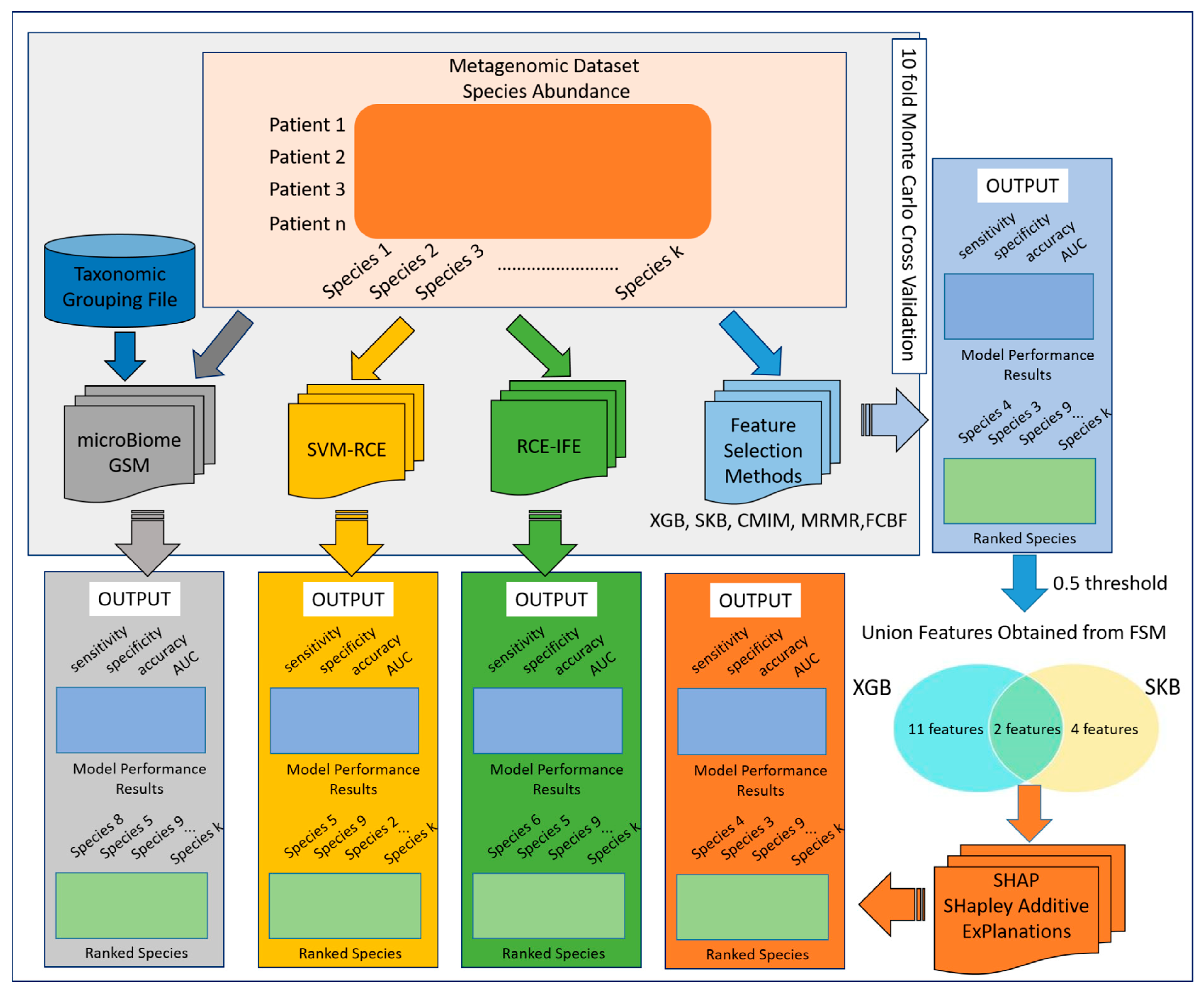
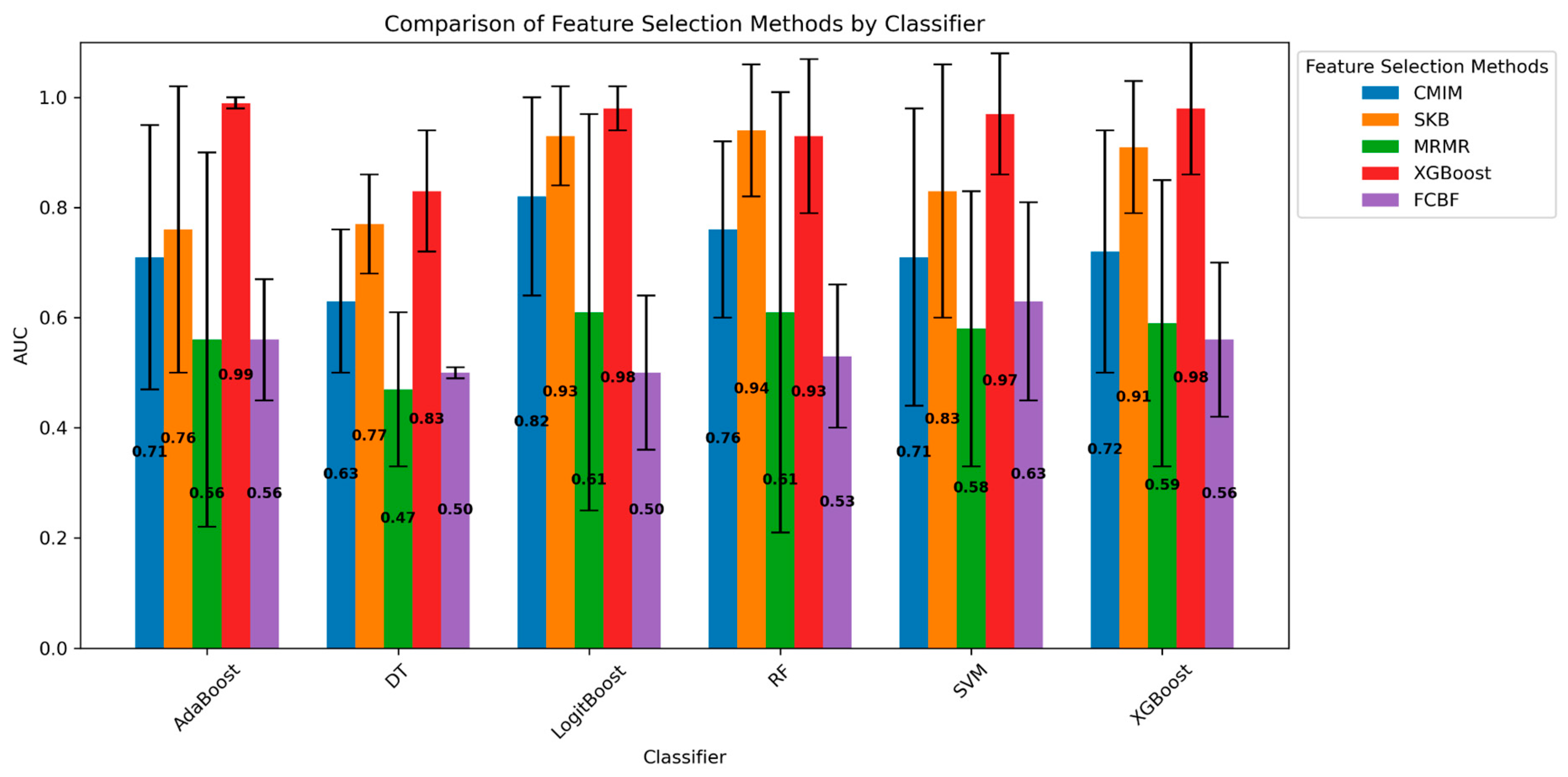

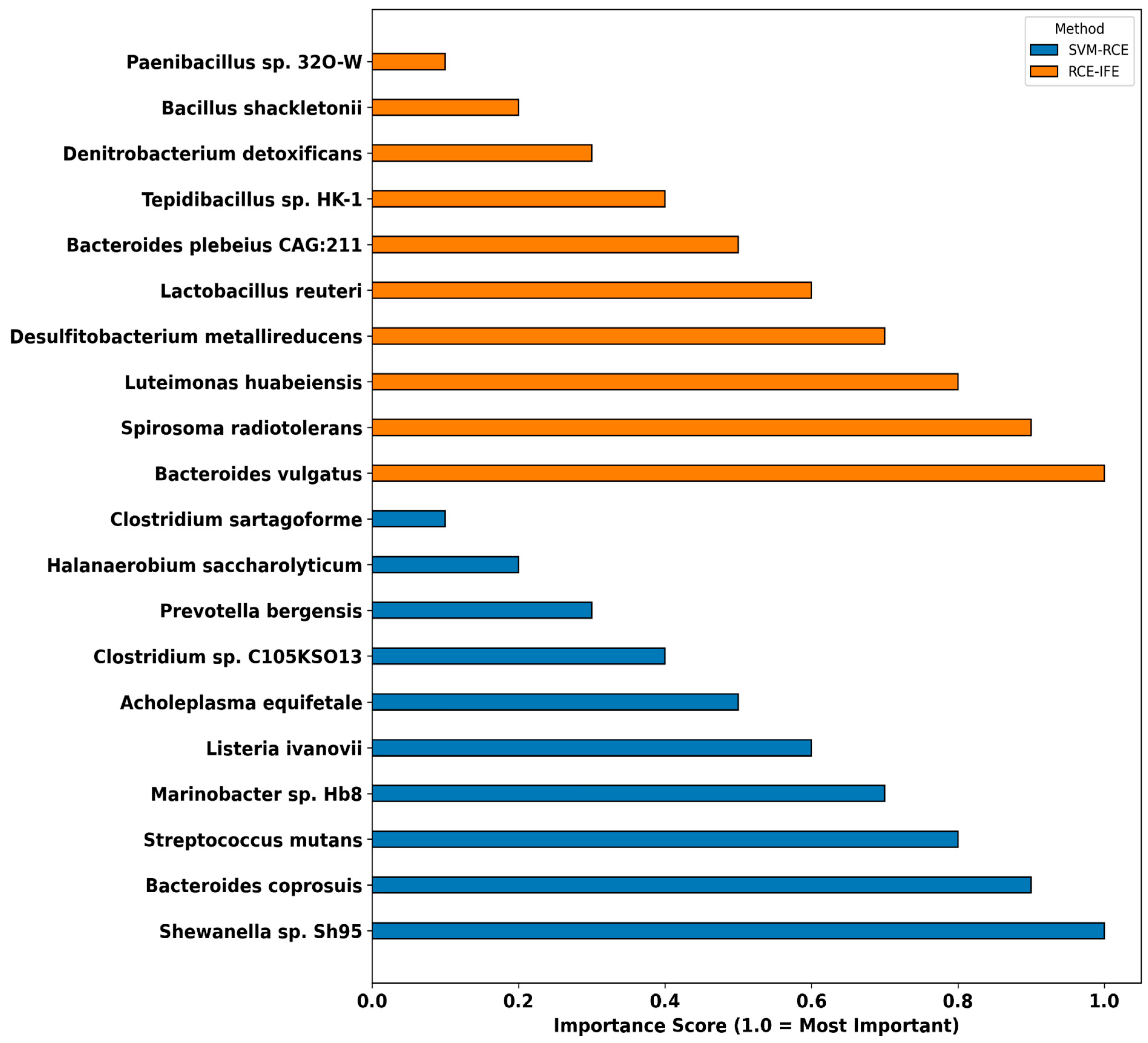
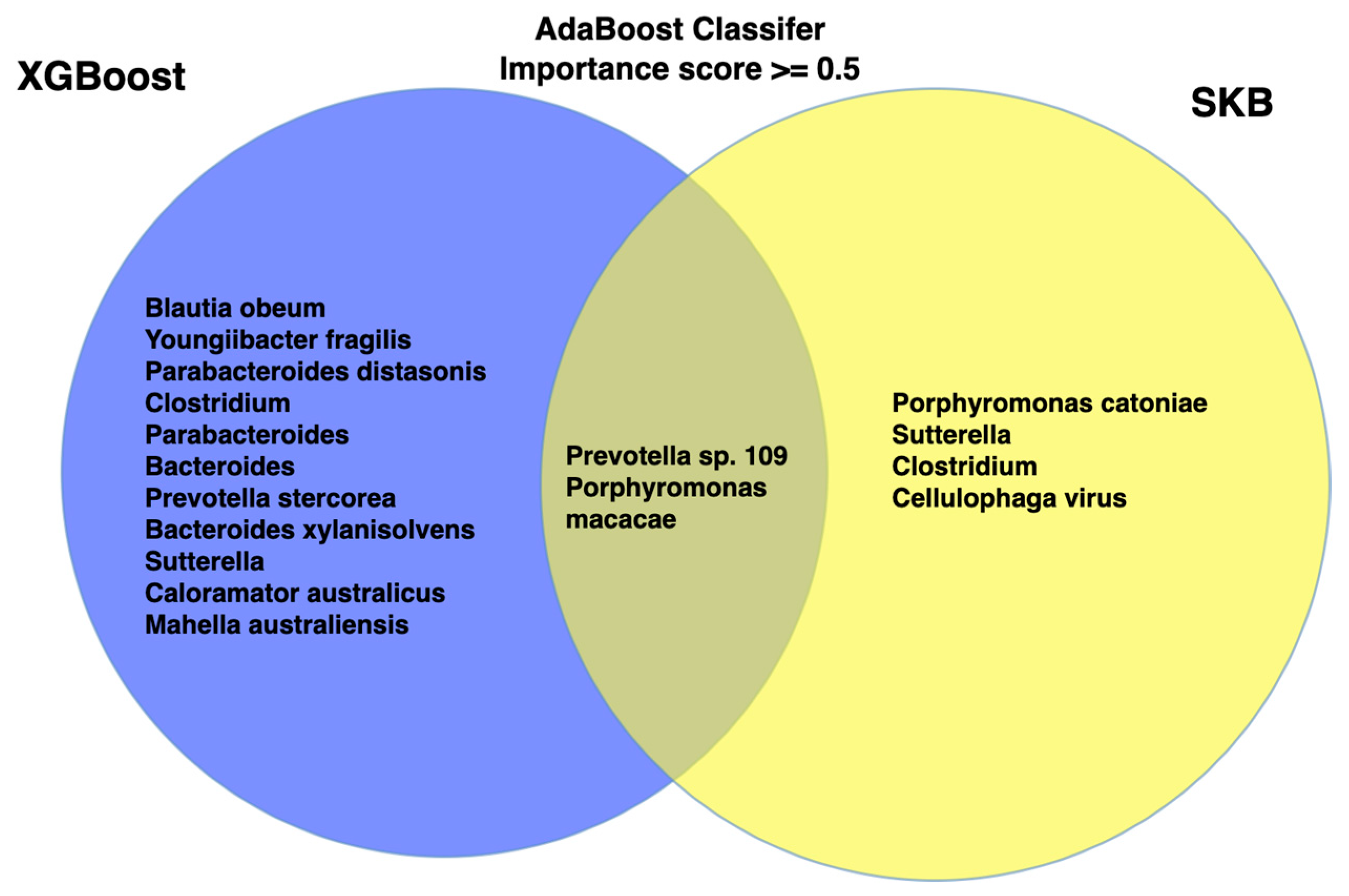
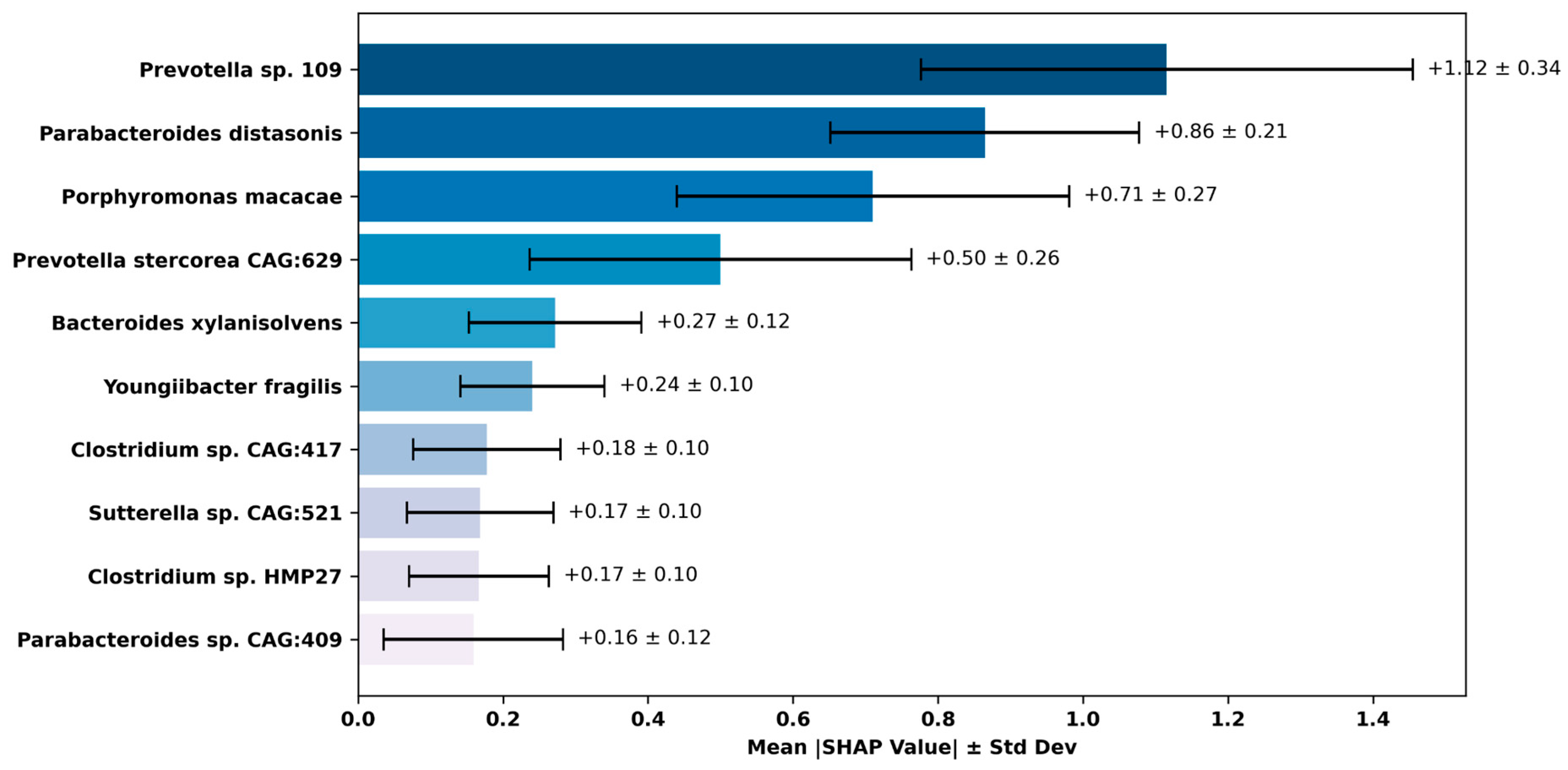
| Group Name | # of Features | Acc | Sens | Spe | F-mea | AUC |
|---|---|---|---|---|---|---|
| Family | 107.3 | 0.80 | 0.80 | 0.80 | 0.82 | 0.95 |
| Genus | 96.9 | 0.78 | 0.85 | 0.70 | 0.81 | 0.96 |
| Order | 125 | 0.77 | 0.83 | 0.70 | 0.80 | 0.90 |
| Methods | # of Features | Acc | Sens | Spe | F-mea | AUC |
|---|---|---|---|---|---|---|
| microBiomeGSM (Genus) | 96.9 | 0.78 | 0.85 | 0.70 | 0.81 | 0.96 |
| SVM-RCE | 135.5 | 0.81 | 0.83 | 0.78 | 0.83 | 0.89 |
| RCE-IFE | 104.8 | 0.83 | 0.88 | 0.76 | 0.85 | 0.94 |
| Model | Accuracy | Sensitivity | Specificity | F-Measure | AUC |
|---|---|---|---|---|---|
| AdaBoost | 0.97 ± 0.03 | 0.96 ± 0.06 | 0.95 ± 0.08 | 0.97 ± 0.03 | 0.99 ± 0.01 |
| Decision Tree (DT) | 0.88 ± 0.10 | 0.89 ± 0.09 | 0.87 ± 0.21 | 0.88 ± 0.07 | 0.88 ± 0.11 |
| LogitBoost | 0.98 ± 0.05 | 0.94 ± 0.09 | 0.95 ± 0.08 | 0.98 ± 0. 04 | 0.98 ± 0.02 |
| Random Forest (RF) | 0.97 ± 0.05 | 0.95 ± 0.07 | 0.92 ± 0.14 | 0.97 ± 0. 04 | 0.98 ± 0.02 |
| XGBoost | 0.98 ± 0.04 | 0.95 ± 0.05 | 0.96 ± 0.09 | 0.98 ± 0.03 | 0.99 ± 0.03 |
| Rank | CMIM | FCBF | MRMR | SKB | XGBoost |
|---|---|---|---|---|---|
| 1 | Bacteroides caccae | Paenibacillus harenae | Bacteroides helcogenes | Porphyromonas catoniae | Blautia obeum |
| 2 | Saccharopolyspora hirsuta | Neisseria sp. 74A18 | Prevotella sp. CAG:1058 | Porphyromonas macacae | Porphyromonas macacae |
| 3 | Nocardia farcinica | Aequorivita viscosa | Butyrivibrio sp. MB2005 | Desulfurobacterium sp. TC5-1 | Youngiibacter fragilis |
| 4 | Sinorhizobium sp. GL28 | Spiroplasma helicoides | Catenibacterium sp. CAG:290 | Clostridium sp. CAG:813 | Prevotella sp. CAG:1185 |
| 5 | Bacteroides cellulosilyticus | Nocardioides jensenii | Bacteroides sp. CAG:189 | Virgibacillus salinus | Phascolarctobacterium sp. CAG:207 |
| 6 | Herbiconiux solani | Prevotella fusca | Prevotella sp. CAG:520 | Necropsobacter rosorum | Prevotella sp. 109 |
| 7 | Acidithiobacillus caldus | Porphyromonas macacae | Capnocytophaga sp. oral taxon 338 | Prevotella sp. CAG:1185 | Clostridium sp. HMP27 |
| 8 | Bacillus sp. 522_BSPC | Pantoea sp. PSNIH2 | Flavobacterium sp. Root901 | Prevotella sp. 109 | Rikenella microfusus |
| 9 | Streptomyces rimosus | Indibacter alkaliphilus | Endomicrobium proavitum | Prevotella sp. CAG:255 | Clostridium cellulosi |
| 10 | Bacillus sp. Leaf13 | Bacillus daliensis | Stigmatella aurantiaca | Bacillus alcalophilus | Pyramidobacter piscolens |
Disclaimer/Publisher’s Note: The statements, opinions and data contained in all publications are solely those of the individual author(s) and contributor(s) and not of MDPI and/or the editor(s). MDPI and/or the editor(s) disclaim responsibility for any injury to people or property resulting from any ideas, methods, instructions or products referred to in the content. |
© 2025 by the authors. Licensee MDPI, Basel, Switzerland. This article is an open access article distributed under the terms and conditions of the Creative Commons Attribution (CC BY) license (https://creativecommons.org/licenses/by/4.0/).
Share and Cite
Temiz, M.; Bakir-Gungor, B.; Ersoz, N.S.; Yousef, M. Machine Learning-Based Prediction of Autism Spectrum Disorder and Discovery of Related Metagenomic Biomarkers with Explainable AI. Appl. Sci. 2025, 15, 9214. https://doi.org/10.3390/app15169214
Temiz M, Bakir-Gungor B, Ersoz NS, Yousef M. Machine Learning-Based Prediction of Autism Spectrum Disorder and Discovery of Related Metagenomic Biomarkers with Explainable AI. Applied Sciences. 2025; 15(16):9214. https://doi.org/10.3390/app15169214
Chicago/Turabian StyleTemiz, Mustafa, Burcu Bakir-Gungor, Nur Sebnem Ersoz, and Malik Yousef. 2025. "Machine Learning-Based Prediction of Autism Spectrum Disorder and Discovery of Related Metagenomic Biomarkers with Explainable AI" Applied Sciences 15, no. 16: 9214. https://doi.org/10.3390/app15169214
APA StyleTemiz, M., Bakir-Gungor, B., Ersoz, N. S., & Yousef, M. (2025). Machine Learning-Based Prediction of Autism Spectrum Disorder and Discovery of Related Metagenomic Biomarkers with Explainable AI. Applied Sciences, 15(16), 9214. https://doi.org/10.3390/app15169214








